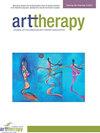Cultural Humility in Art Therapy: Applications for Practice, Research, Social Justice, Self-Care, and Pedagogy
IF 1.3
Q3 PSYCHOLOGY, CLINICAL
引用次数: 9
Abstract
Jackson is clear that cultural humility as a skill set and a state of being may be difficult for some since it is not a “one-size fits all approach” (p. 19). She also recognizes challenges with cultural humility in comparison to like topics. Jackson discusses her early struggles with the word humility, which could diminish the importance of the work of previous art therapy leaders who referred to “cultural competence” (p. 15). By taking the time to explore the historical relevance art therapy has had in cultural awareness, Jackson draws from the work of early pioneer African American art therapists like Georgette Seabrook Powell and Sarah McGee who began the dialogue on the need to adopt different perspectives and methodologies in art therapy. The book is organized into chapters that focus on the elements of cultural humility important for art therapists’ and their practice. Each chapter concludes with a reflective perspective along with an art exercise designed to engage the therapist. Besides Chapter 1 (Introduction), all other chapters describe characteristics – conceptualized as body, eyes, hands, heart, circle, symbols – derived from Jackson’s (2016) doctoral research on the creative responses of the African American art therapists and allied mental health professionals. In Chapter 2, Jackson discusses cultural humility in art therapy research and assessment using the metaphor of body, offering, “a platform of discovery in cultural humility” (p. 54). She begins by exploring the Western influence of knowing, which many see as the origin of art therapy. Knowing, in this way, has been unduly assigned to other cultures, creating a power imbalance. Practitioners can “honor other ways of knowing, leading the therapist to a greater cultural awareness” (p. 39). One example provided is related to the use of language in assessment and how art can provide ways of knowing unlimited by words. Jackson states, “understanding the tacit meanings of art requires the art therapist practicing cultural humility to be attuned to cultural implications” (p. 39). The practice of art and art therapy become the means where tacit knowledge is examined and considered. In Chapter 3, Jackson describes why art therapists should consider cultural variables; self-identity, gender/ sexual orientation, and working in communities with individuals who are unfamiliar with art therapy. The power differential that exists between clients and therapists is another variable often not acknowledged. Having cultural humility means asking “how can I work with the client?” (p. 76). Practicing art therapy in this way can help to eliminate many potential barriers between the client and therapist. Art therapists can examine how their clients experience oppression in society and be reflective in how they themselves hold and wield power and privilege. In Chapter 4, Jackson explores the importance and relevance of community-based art therapy, which has implications for increasing accessibility to those who might otherwise not have it. She exemplified inclusivity in her own work with youth in residential treatment as she considers their need for expression creating projects that invite them in influencing their communities using art. When working with community groups or spaces, Jackson is sensitive to how her presence may be interpreted by the clients she serves. If therapeutic interventions are to be effective and exercise cultural humility, the underlying systems must expand their perspective to incorporate the expertise that already exists within it. Community residents already know what they need; it is not the therapist’s job to fix them or improve their plight. The book balances the subject matter, art responses from African American art therapists who were included in Jackson’s dissertation research, and her shared experiences. Chapter themes support the importance of increasing cultural diversity and inclusion. However, perspectives from practicing art therapists of other ethnicities are only minimally provided. Additionally, insights from those of different gender identities would艺术治疗中的文化谦逊:在实践、研究、社会正义、自我关怀和教育学中的应用
Jackson很清楚,文化谦逊作为一种技能和一种存在状态对一些人来说可能是困难的,因为它不是“一刀切的方法”(第19页)。她也认识到与类似话题相比,文化谦逊带来的挑战。Jackson讨论了她早期与谦卑这个词的斗争,这可能会降低先前艺术治疗领导者提到的“文化能力”的重要性(第15页)。通过花时间探索艺术疗法在文化意识中的历史关联,杰克逊借鉴了早期先驱非裔美国艺术治疗师的作品,如乔吉特·西布鲁克·鲍威尔和莎拉·麦吉,他们开始讨论在艺术治疗中采用不同观点和方法的必要性。这本书分为几个章节,重点关注对艺术治疗师及其实践重要的文化谦逊元素。每一章都以反思性的观点以及旨在吸引治疗师的艺术练习结束。除了第1章(引言),所有其他章节都描述了特征-概念化为身体,眼睛,手,心,圆,符号-源自杰克逊(2016)对非裔美国艺术治疗师和相关心理健康专业人员的创造性反应的博士研究。在第二章中,Jackson使用身体的隐喻讨论了艺术治疗研究和评估中的文化谦卑,提供了“一个发现文化谦卑的平台”(第54页)。她首先探索了西方对认知的影响,许多人认为这是艺术疗法的起源。以这种方式,知识被过度地分配给了其他文化,造成了权力的不平衡。从业者可以“尊重其他的认知方式,引导治疗师获得更大的文化意识”(第39页)。提供的一个例子与语言在评估中的使用有关,以及艺术如何通过语言提供无限的认识方式。杰克逊说,“理解艺术的隐性意义需要艺术治疗师实践文化谦逊,以适应文化含义”(第39页)。艺术实践和艺术治疗成为检验和思考隐性知识的手段。在第3章中,Jackson描述了为什么艺术治疗师应该考虑文化变量;自我认同,性别/性取向,以及在社区中与不熟悉艺术治疗的人一起工作。来访者和治疗师之间存在的权力差异是另一个经常不被承认的变量。拥有文化上的谦逊意味着问自己“我该如何与客户合作?”(第76页)。以这种方式进行艺术治疗可以帮助消除来访者和治疗师之间的许多潜在障碍。艺术治疗师可以检查他们的客户如何在社会中遭受压迫,并反思他们自己如何掌握和行使权力和特权。在第4章中,Jackson探讨了以社区为基础的艺术治疗的重要性和相关性,这对于增加那些可能没有艺术治疗的人的可及性具有重要意义。她在自己的工作中以包容为例,她考虑到他们对表达的需求,创造项目,邀请他们用艺术影响他们的社区。当与社区团体或空间合作时,Jackson对她所服务的客户如何解释她的存在非常敏感。如果治疗干预是有效的,并行使文化谦逊,基础系统必须扩大他们的观点,以纳入已经存在的专业知识。社区居民已经知道他们需要什么;治疗师的工作不是修复他们或改善他们的困境。这本书平衡了主题,非裔美国艺术治疗师的艺术反应,他们包括在杰克逊的论文研究中,以及她的共同经历。各章节的主题支持增加文化多样性和包容性的重要性。然而,来自其他种族的艺术治疗师的观点只是最低限度的提供。此外,来自不同性别认同的人的见解会
本文章由计算机程序翻译,如有差异,请以英文原文为准。
求助全文
约1分钟内获得全文
求助全文

 求助内容:
求助内容: 应助结果提醒方式:
应助结果提醒方式:


